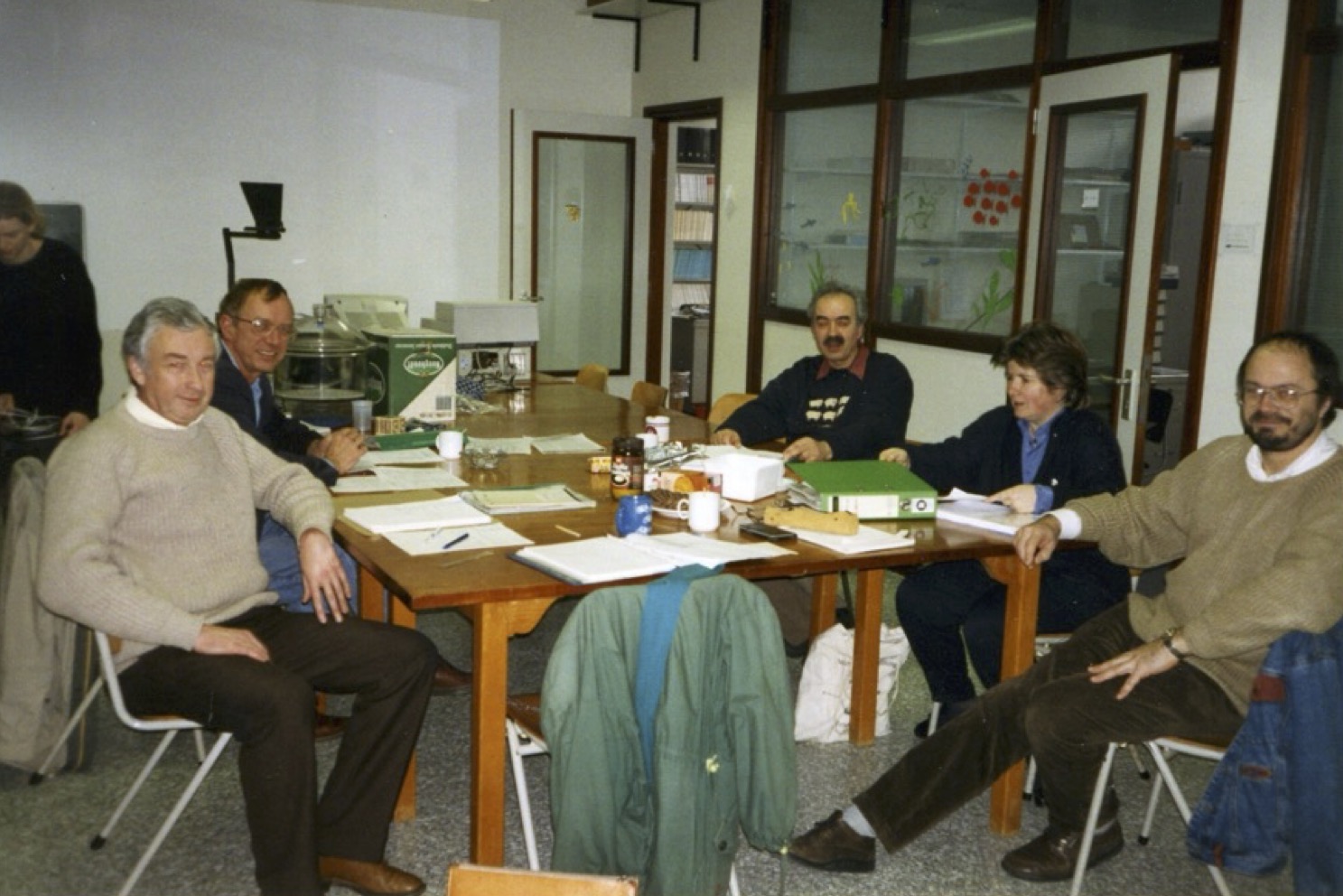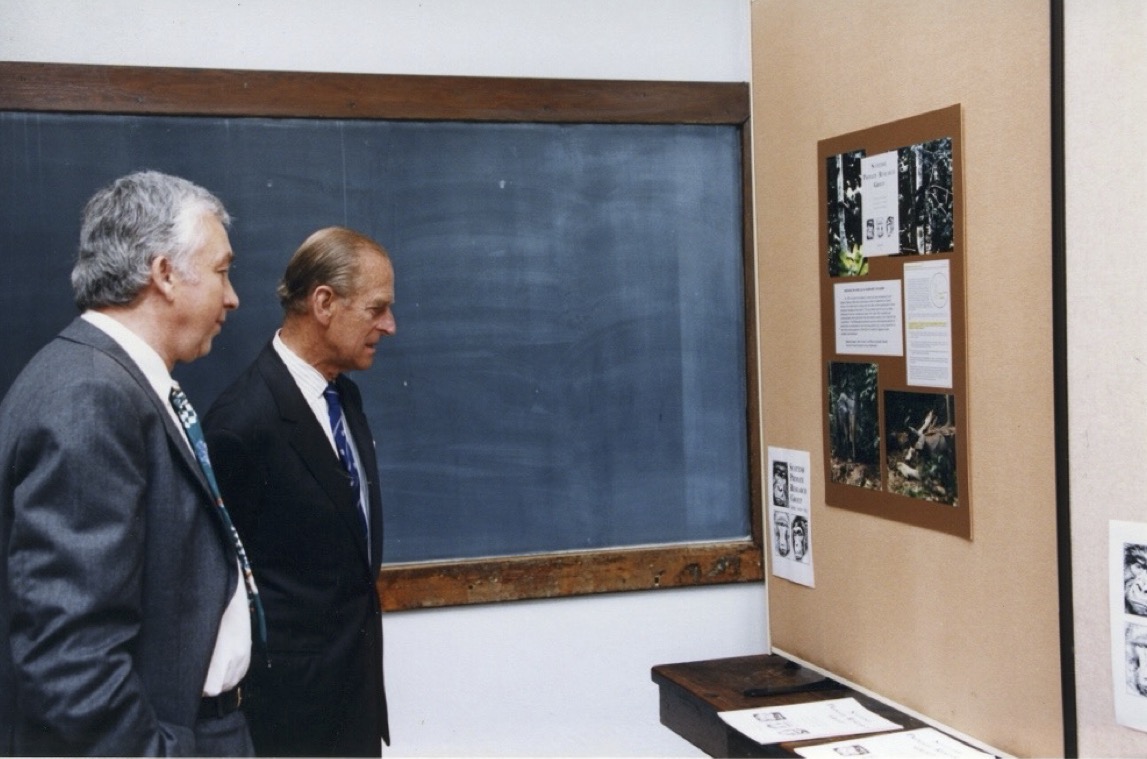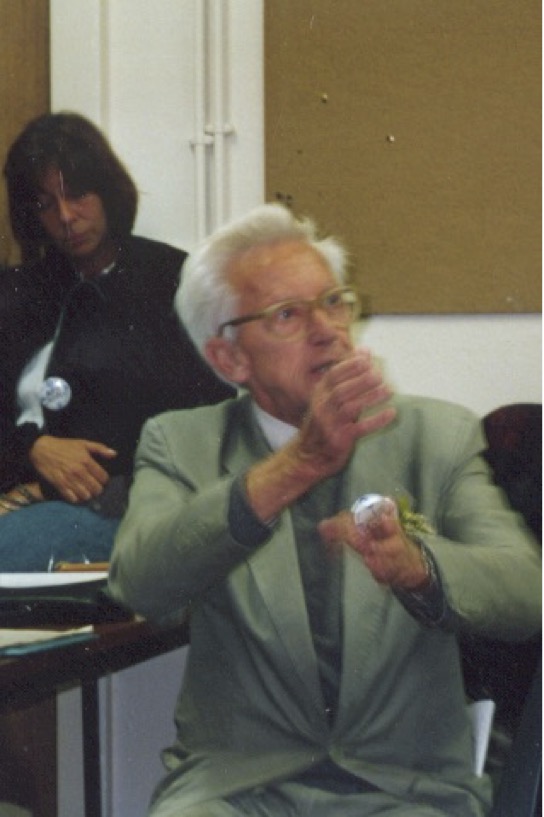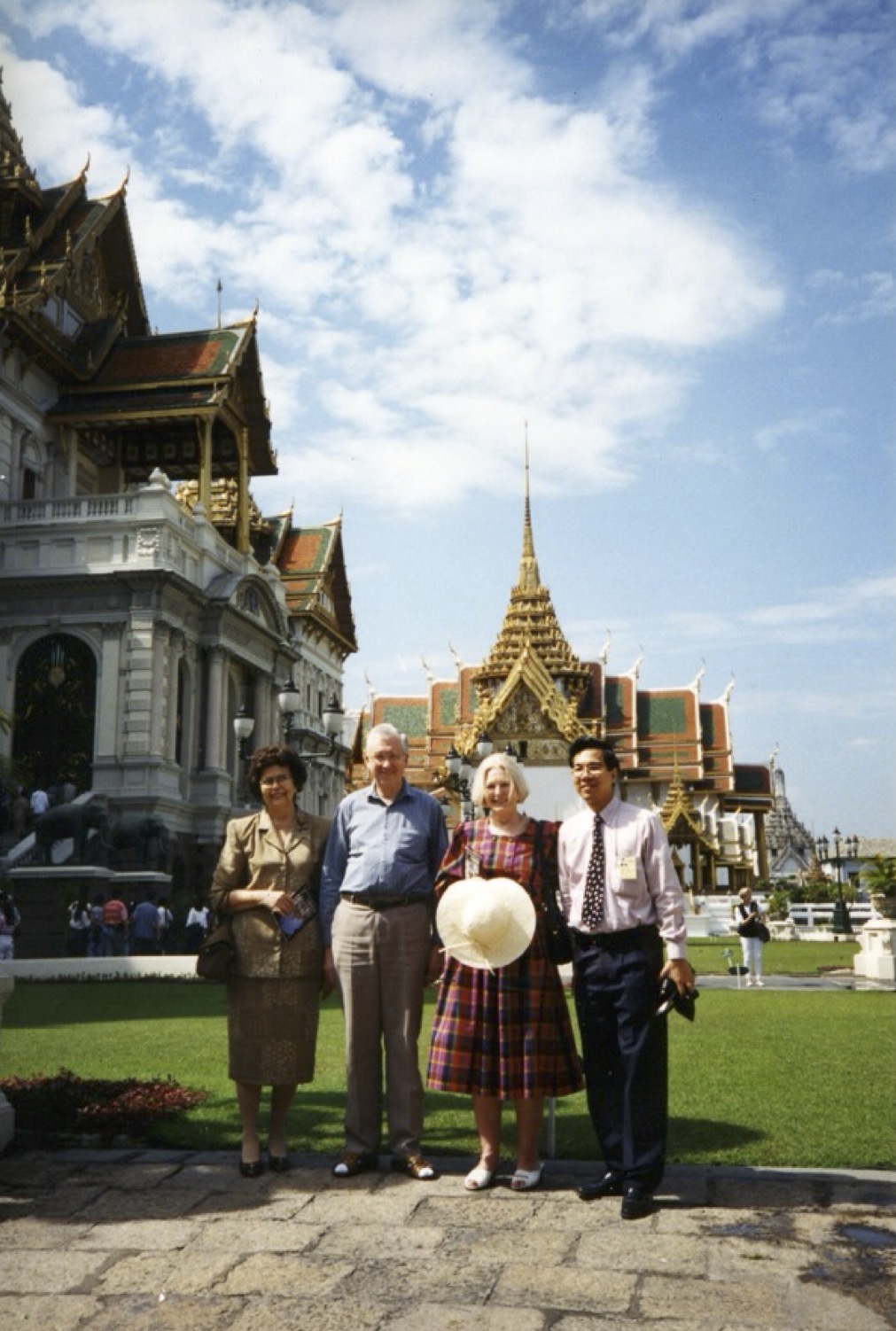The next year I reported my Drosophila work at an International Symposium on Comparative Endocrinology in Malaga, Spain, and then at the Gordon Conference on Chronobiology held in New Hampshire. For the second of these meetings I flew to Boston, hired a car, and drove up to Plymouth, New Hampshire, staying overnight in a motel on the shores of Lake Winnepesaukee. The next day I continued over the White Mountains – stopping to watch a cycling time trial – to arrive at the small college which was hosting the meeting.
1990 saw my appointment to a personal chair of Insect Physiology at the University of Edinburgh. I was also invited to a meeting of the Polish Physiological Society in Cracow. Jean suggested that we should make this trip our annual holiday – and that we should drive there! So we arranged a mammoth five-day journey across Europe, first down to the channel ports, then across northern France to stay with Michael and Corinne, now living in Strasbourg, and then across Germany. Just short of the Czech border we stayed in a delightful hotel at Hirschau, eastern Bavaria, which we were to use again on the return journey. Crossing the Czech border at Waldhaus we continued on through Plzen and Pisek to Ceske Budejovice to pay a visit to Ivo Hodek and his wife Magda Hodkova at the Institute of Entomology. It was only in the middle of the night did we realise that we had a visa problem! We had obtained single Czech visas instead of ‘double-entry’ ones, so that once we left the Czech Republic for Poland we would not be allowed re-entry on our return journey. We left that problem for later - and continued on with our trip the next day through Brno and Olomouc, across the border into Poland at Cieszyn, and down into Krakow. This was my third visit to Poland. In 1983 the political system was opening up because of the activities of Solidarnosc. On the second visit (1987) the dead hand of communism had descended once again. This time the country was opening up as a market economy - and suffering from extreme inflation. Upon arrival at our hotel in Cracow I gave a tip of 10,000 złoties to the parking attendant (more than enough, I thought!) but was told that this would only buy his family one bread roll! When paying for a meal in the hotel we had to be very careful counting all the noughts. A few months after our departure, however, the Polish government solved this problem quickly and easily just by moving the decimal point!

In Cracow, 1990
The conference was successful, and I was presented with a medal from the Polish Physiological Society. Our attendance at the meeting, however, was severely curtailed because we had to go through to Katowice, the nearest Czech consulate, in order to obtain another set of visas for our return journey. We then retraced our way back across the Czech Republic, but this time through Prague to visit Jan and Eva Zdarek. In this we were extremely fortunate. Since we had made such good time on our return, we arrived in Prague a day earlier than expected and found that our hosts had gone away for the weekend. We failed to find a hotel room in Prague and were just contemplating a night in the car when Jan and Eva came round the corner and rescued us from our plight! The next day we continued on through Karlovy Vary and Marianske Lazne, to cross the German border at Cheb, and on to spend another night of luxury in the hotel at Hirshau. The return journey to Scotland involved an overnight stay in Strasbourg, and then a monumental day’s journey from Strasbourg to Robert and Carol’s flat in North London! Driving north from London on October 1st – the first day of my professorship – the timing belt on the car broke, but we managed to glide into the side of the motorway without causing a pile-up. For some unknown reason we didn’t think of contacting the local Ford agent, but found an excellent garage and, after an unscheduled overnight stop, continued on to Edinburgh.
Earlier in 1990 I received a telephone call from Serge Daan asking whether I would like to join him and Günther and Gerta Fleissner in organising a series of European summer schools on Chronobiology, funded by the Erasmus programme of the EU, and rather along the lines of the highly successful prototype held at Pacific Grove in 1977. The initial plan was to organise three such summer schools, one in Groningen (1991), one in Frankfurt (1992) and one in Edinburgh (1993). Each was to last a month and to cater for up to 20 students from various EU Universities, with the students attending lectures by visiting ‘experts’ and conducting a small research project. Organisation of these summer schools involved a number of committee meetings, either in Groningen, Frankfurt, Edinburgh, or during a marvellous autumnal weekend at Jürgen Aschoff’s house in Nottweiler. There was no meeting in 1994, but the summer schools restarted in 1995 and ran on for a number of years in a shortened, one-week, form in Florence, Munich, Erling Andechs and at Ascot, Berkshire. After the first three, however, despite their obvious success, the money got harder and harder to obtain and they eventually came to an end until re-initiated by Till Roenneberg a few years later (see below).

At an Erasmus summer school committee meeting, Groningen 1991; left to right: me, Serge Daan, Gunther Fleissner, Gerta Fleissner and Menno Gerkema
Apart from the summer school in Groningen and a Gordon conference on Chronobiology held at Irsee, Bavaria, the highlight of 1991 was my second visit to Japan. The main reason for going was an invitation from Klaus Hoffmann to speak at the 3rd International Congress of Comparative Physiology and Biochemistry in Tokyo but, having gone that far, I became involved in three other meetings. I flew out to Tokyo and was met at the airport by Seiji Tanaka who put me up at their apartment for the night. The following morning I was put on a bullet train with a bento box for my lunch and travel directions written in Japanese should I got lost! The train travelled north from Tokyo through Sendai to Morioka where I got off. Here my Japanese travel instructions came in useful, for I had to cross the line by a footbridge, exit the station and find the bus to Hirosaki. Here I was met and looked after by Sinzo Masaki. While I was in his department at Hirosaki University I seemed to be entertained like a member of the royal family. The students put on a poster session of their work for my perusal, and the next day they went down to the beach and came back with a collection of marine delicacies for a barbeque, which included various sorts of Crustacea, Mollusca, Echinoderms, seaweed and, of course, fish. Sinzo also took me on a trip to nearby Mt Iwaki: this is a mountain he has climbed about 350 times, each time picking up the litter scattered by less careful citizens. He said that he was the ‘guardian of the mountain’ – what an exemplary member of the human race!
The next day Sinzo and I continued by rail, through the Seikan tunnel to Hokkaido and on to Sapporo, where we met other delegates for the 4th Sapporo Conference on Biological Rhythms. The meeting was expertly organised by Tsutomu Hiroshige and Ken-ichi Honma and published the following year as Circadian Clocks from Cell to Human. The Honma Prize lecture was given by Jay Dunlap, and other delegates included Jurgen Aschoff, Serge Daan, Woody Hastings and Carl Johnson, in addition to a number of eminent Japanese researchers. Sapporo is famous for its beer – it was pointed out that it was on the same latitude as Munich – and we went out to dine at an enormous Mongolian restaurant, cooking our own slices of beef on upturned grills shaped like Genghis Khan’s helmet!

At the Tsukuba meeting; Right to left: Sinzo Masaki, myself, David Denlinger and Klaus Hoffmann
A couple of days later our crowded schedule took us on a flight from Sapporo back to Tokyo where we went to the research Institute at Tsukuba, just north of the city. A small meeting had been organised there on Insect Biochronometry, attended by Sinzo Masaki, Seiji Tanaka, Dave Denlinger, Jim Truman and Klaus Hoffmann, among others. Finally we transferred to our main reason for visiting Japan, the 3rd International Congress of Comparative Physiology and Biochemistry. This meeting was held in a large conference centre in a suburb to the west of Tokyo. On departure, travel to the airport at Narita, some forty miles to the east of the city, involved a train ride to the city centre and then another train out to the airport. Since my departure for London was at 10.00 a.m., I had to make a very early start, catching the first train in the morning, before the ticket office at the station even opened for business. Luckily, when I was down in the local shopping area looking for a pair of ear-rings for Jean, I met Professor Yamashita who kindly escorted me to the station and arranged for a ticket to be issued with the next day’s date. Thus armed, I called a taxi for 4.00 a.m., caught the first Tokyo-bound train, made the necessary connection and arrived at the airport in time for the check-in.
I also read a paper on my Drosophila work the following year (December 1992) at a meeting of the Entomological Society of America, in Baltimore, Maryland. These meetings are enormous with about 3,000 delegates and a programme divided into umpteen separate symposia. My talk was part of a symposium on the molecular and genetic aspects of circadian rhythmicity. I spent quite a lot of the time with Jeff Hall and we went together to the famous Baltimore aquarium. I also had a pleasant meal with Noelle Granger, reminiscing about old times in Chapel Hill. At the end of the meeting I drove with Jaga Giebultowicz back to her home in Silver Springs, Maryland, making our way down the freeway just as a blizzard set in. By the time we got to her house the snow was quite bad and, by the time of my departure, all airports in the New York and Boston area were closed. This meant an unwanted diversion from Dulles airport inland to Detroit before catching a transatlantic flight to London.

Prince Philip, Duke of Edinburgh, visits the Department
In 1993 I was appointed Chairman and Head of the Institute of Cell, Animal and Population Biology (Buggins’s turn!), a position I was to hold for the next four years. Apart from the day-to-day running of a very large and busy University department of over 200 people, my duties also included acting as host when the Chancellor, Prince Philip the Duke of Edinburgh, paid us a visit (see photograph).
We also held the Erasmus Summer School in Edinburgh that year which covered all aspects of Chronobiology but specialised on photoperiodism. Luckily, at that time I had Bob Lewis working in my lab for the second of his sabbaticals in Edinburgh, Bron Cymborowski for six weeks on a British Council grant, and two new students in Shaun Gillanders, working on Drosophila period mutants, and Seau-Feng Hong from Taiwan, working on Calliphora activity. Apart from helping with the summer school they provided excellent collaboration on Calliphora research, Bob with the more technical aspects of activity recording, and Bron bringing with him a supply of a non-steroidal ecdysteroid agonist, RH 5849. We found that topical application of this compound caused consistent phase shifts of the circadian activity rhythm with phase advances in the early subjective night and phase delays in the late subjective night. These effects were the opposite - but not the mirror image - of phase responses to short light pulses. We concluded that ecdysteroids, which are mimicked by RH 5849, might act as entraining agents via the output pathway by feedback to ‘clock’ neurons in the brain. This work was published in the Journal of Comparative Physiology.

At the Edinburgh Erasmus Summer School: Jürgen Aschoff in full flow
Bron also brought with him his undoubted skill as a micro-surgeon, which he used in an attempt to determine the anatomical locations of the photoreceptors and circadian pacemakers in Calliphora. We found that cuts between the optic lobes and the brain, or complete removal of the optic lobes, failed to interrupt the circadian rhythm of locomotor activity or its entrainment to the light cycle. This demonstrated that the pacemakers were not in the optic lobes of Calliphora - or these structures were not essential for the expression of rhythmicity. It was also clear that photoreception was most likely conducted by the central brain, although photic input through the compound eyes and optic lobes in intact flies could not be ruled out. In these aspects, the blow fly was different from, say, the cockroach in which the compound eyes are the main photoreceptors, and the circadian pacemakers are located within the optic lobes.
I was invited to the Zoology department in Cambridge to give a talk, and also went to a small workshop on Rhythms in Drosophila, held at the University of Virginia in the summer of 1994. To get to the latter meeting I flew to Washington D.C. and then took a small plane to the local airport in Charlottesville. After the meeting, the return journey gave me some excitement. The flight from Charlottesville to Dulles airport was delayed for a couple of hours, so I had to run for the transatlantic flight to London. I made that connection - but only after the flight had been held up for me. As I climbed aboard, the black looks from my fellow passengers told it all!
The decade came to an end with a trip to Hong Kong to spend Christmas and the New Year with Richard, Sue and our first grandchild, David. Not only was David named after me, but he was born on March 13th 1993 – the same date as my birthday (March 12th) since Hong Kong time was about 8 hours ahead of GMT! The 1994 trip to Hong Kong was the first of six such visits over the next 14 years, during which we got to know the colony - later ‘special economic zone’ - very well - in all its alleyways, outlying islands and the New Territories.
Before our first visit to Hong Kong we made a stop-over in Bangkok to see Lavan, one of Jean’s friends from her days at secretarial college many years ago. She and her husband entertained us right royally. We were conducted around the royal palace, visited many of the royal apartments not normally open to the public, and were entertained by a troupe of Thai dancing girls whilst seated on a raised dais and served cooling drinks! A trip was also made to the ancient site at Ayutthaya, just to the north of Bangkok.

At Ayutthaya, north of Bangkok

With Lavan in the palace grounds, Bangkok
After our stop-over in Bangkok we flew on to Hong Kong, landing at the old airport with its steep inward flight path over the harbour. During our many visits to Hong Kong (1994, 1997, 2000, 2003, 2006, 2008) we grew to love this vibrant metropolis -- crossing the ‘fragrant harbour’ on the Star ferry to Kowloon, taking the tram to the Peak, and walking around Lugard’s walk to see the extraordinary views of this unique city. Trips were made to many of the inhabited islands, including Lamma, Lantau and Cheung Chau, and in 1997 we took the ferry across to Macau.

Hong Kong from the Star Ferry
